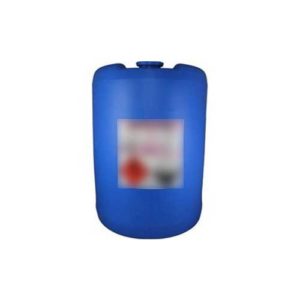PHENOL C6H5OH
ABOUT:
The cumene process is the most widely used method for the commercial production of phenol.
- In the first step of the cumene process, benzene and propylene are reacted in the presence of an acid catalyst (usually phosphoric acid) to produce cumene.
- Next, cumene is oxidized using air or oxygen at high temperature and pressure in the presence of a metal catalyst (usually chromium or cobalt) to produce cumene hydroperoxide.
- The cumene hydroperoxide is then cleaved using sulfuric acid to produce phenol and acetone as byproducts.
- The phenol and acetone are then separated by distillation, with acetone being used as a valuable co-product in various industrial processes.
PHYSICAL PROPERTIES:
Appearance: colorless or slightly pink crystalline solid
Odor: distinctive odor
Melting point: 40.5°C
Boiling point: 181.8°C
Density: 1.07 g/cm³
Viscosity: Phenol has a relatively high viscosity, meaning it flows slowly. Its viscosity decreases as the temperature increases.
pH: Phenol is slightly acidic with a pH value of around 5.5
Phenol is soluble in water, but as the temperature rises, so does the solubility. Moreover, it dissolves in organic solvents like benzene, ethanol, and ether.
CHEMICAL PROPERTIES:
- Phenol is a weak acid with a pKa value of 9.95. It can donate a proton (H+) to form phenolate ion (C6H5O−), which is stabilized by resonance.
- Phenol is a reactive compound due to the presence of the hydroxyl group (-OH) on the aromatic ring. It can undergo a range of chemical reactions, including electrophilic substitution, nucleophilic addition, and oxidation.
- Phenol can be oxidized to form quinones, which are important intermediates in biological processes.
- Phenol can undergo polymerization to form a variety of synthetic resins, including Bakelite, which is a thermosetting plastic.
- Phenol can undergo halogenation, where halogen atoms (such as chlorine or bromine) can be added to the ring, yielding products like 2,4,6-tribromophenol.
- Phenol can undergo esterification, where it reacts with a carboxylic acid to form an ester.
- Phenol can undergo nitration to form nitrophenols, which are used in the synthesis of dyes and pharmaceuticals.
APPLICATIONS:
PRODUCTION OF PHENOLIC RESINS:
- Molded plastics for consumer items, automobile parts, and electrical components are made with phenolic resins.
- Due to their superior bonding abilities and resilience to heat and chemicals, phenolic resins are employed as coatings and adhesives.
- Due to their outstanding thermal insulation qualities, phenolic resins are employed as insulation materials in building and construction applications.
- Phenolic resins are utilised as binders in abrasive products like sandpaper and grinding wheels.
PRODUCTION OF CAPROLACTAM:
- Caprolactam, a crucial step in the creation of nylon 6, is produced using phenol.
- A synthetic polymer with outstanding mechanical and thermal properties, nylon 6 is utilised in a variety of applications.
- Textiles, different vehicle components, and electrical components are all made with nylon 6 fibres.
PRODUCTION OF BISPHENOL A:
- Phenol is a crucial raw element in the synthesis of bisphenol A (BPA), a chemical substance used to make epoxy resins and polycarbonate polymers.
PHARMACEUTICAL INDUSTRY:
- Strong topical antiseptics like mouthwash, throat sprays, and disinfectants are made with phenol, which has a number of other uses.
- During minor surgical procedures like incision and abscess drainage, phenol is utilised as a local anaesthetic.
- Phenol is a preservative used in the production of some medications, including insulin.
- The manufacturing of several medications, including antifungal and antibacterial medicines, uses phenol derivatives as active pharmaceutical ingredients, such as carvacrol and thymol.
DISINFECTANTS AND ANTISEPTICS:
- It works well against a variety of germs, including viruses, fungus, and bacteria.
- It is used to make soaps and detergents for commercial and domestic cleaning.
EXTRACTION OF FATS AND OILS:
- The extraction process involves using phenol to selectively dissolve lipids from the sample, while leaving behind other components such as proteins and carbohydrates.
- Phenol extraction is frequently used to eliminate undesired impurities and enhance the quality of the finished product in the manufacturing of edible oils, including soybean, maize, and canola oil.
- Moreover, it is used to determine the amount of lipids present in a variety of materials, including plant tissues, milk, and blood.
SAFETY MEASURES:
- Gloves, goggles, or a face shield, as well as a lab coat or other protective apparel, are all required PPE for workers.
- Phenol can emit fumes that, if inhaled, can be dangerous. To get rid of fumes and vapours, make sure the workspace is well-ventilated or utilise a fume hood.
- Phenol needs to be handled carefully and stored in a cold, dry area away from heat and ignition sources. It must be kept in a container that is adequately sealed and clearly labelled.
- Employees should receive first aid instruction in the event of phenol exposure or unintentional intake. When coming into touch with phenol on the skin or in the eyes, you should immediately seek medical assistance.
- Phenol waste should be disposed of according to local regulations and guidelines. It should not be poured down the drain or disposed of in the regular trash.





Reviews
There are no reviews yet.